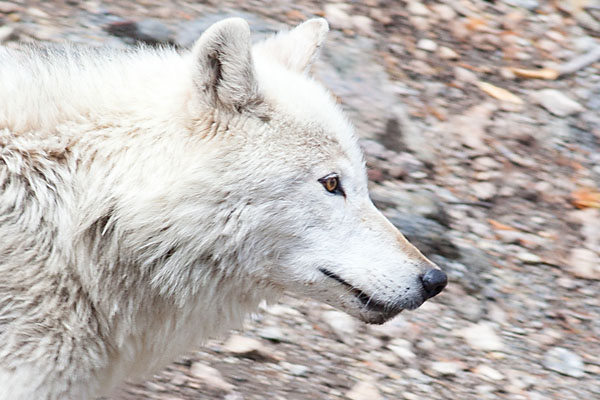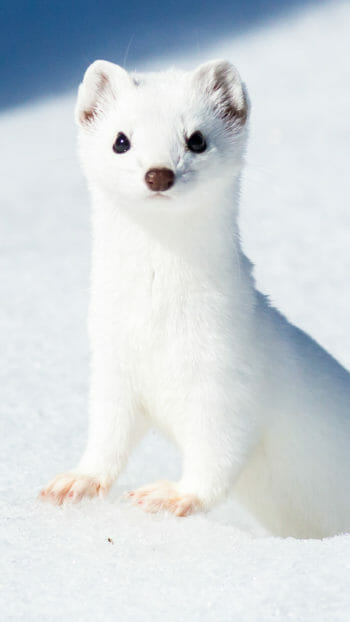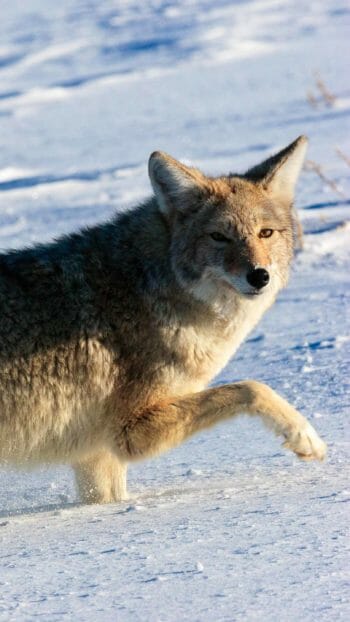The wind was howling outside last night as I lay in bed devouring Decade of the Wolf by biologist Doug Smith and author Gary Ferguson. I stayed up way too late reading but the book is hard to put down as it follows the lives of the first reintroduced wolves and the world famous packs they established throughout Yellowstone. I was still thinking about wolves as I drove in to town from my house north of the town of Jackson, Wyoming. Just over a mile down the old farm road from my house, like a dream from reading about wolves all night, a large grey wolf came barreling out of the trees on the left side of the road. In a flash the unmistakeable blur was staring at me from the opposite side of the road after his harrowing, and slightly over dramatic, crossing. He watched me carefully before trotting deeper into the forest out of sight.
As I watched him disappear behind the large cottonwoods and tangled underbrush I sensed that I was the one being watched. As I retraced his tracks from right to left down into the forest on the opposite side of the road I was met with the stare of yet another beautiful, and huge, grey wolf. Those deep, wild eyes were transfixed on me as she made the decisions to retreat into the forest to wait for me to leave. I was sad to see her go but I understand – in her mind I might have a gun and the recent Wyoming wolf hunts have definitely made the wolves of Jackson Hole more weary of humans.
My heart was pounding, as no matter how many of these encounters you have (and I have had more than my fair share as a wildlife guide), seeing a wolf up close and personal is exciting. There is a wildness inherent in wolves that transcends even our best attempts to understand and ‘know’ what wildness really is. Their eyes tell their story and it cannot be described easily with words. The famous conservationist, Aldo Leopold is known to have killed wolves as a young forester until he saw what was in their eyes. He later wrote about his experiences and said, “We reached the old wolf in time to watch a fierce green fire dying in her eyes. I realized then, and have known ever since, that there was something new to me in those eyes – something known only to her and to the mountain. I was young then, and full of trigger-itch; I thought that because fewer wolves meant more deer, that no wolves would mean hunters’ paradise. But after seeing the green fire die, I sensed that neither the wolf nor the mountain agreed with such a view “.
Arguably the most iconic predator in the Greater Yellowstone Ecosystem, the re-introduction of wolves in 1995 is one of the great conservation success stories of modern time. Despite having once roamed most of the United States and Canada, they had been largely eliminated in the lower 48 states by the early 1900’s. As a target of cattlemen, settlers and hunters across the west, the wolf was seen as threat to the livelihoods of these early western pioneers. They were shot, trapped and poisoned with an almost religious enthusiasm. The vitriolic hatred against wolves lead to the last confirmed wolf being killed within Yellowstone in 1926. Even park managers at that time believed eliminating wolves from the park would lead to healthier game populations. This was before the establishment of modern ecology in park management that recognized the importance of predator-prey relationships in maintaining a healthy, intact ecosystem.
As attitudes about conservation, land management and predators changed throughout the 50’s and 60’s the stage was set for the catalyst that would really change the conversation. In 1973 the Endangered Species Act was passed which required federal agencies, including the National Park Service, to not only protect endangered species alive today, but also to restore species to places where they had been eliminated. Despite significant resistance to bringing wolves back to Yellowstone, the public outcry in favor of reintroduction coupled with legislative prudence and sound biology lead to the first 14 wolves released in Yellowstone in January of 1995. The wolves were brought from Canada where they had been captured from wild populations in similar habitat to that found in Yellowstone. Another 11 wolves were released the next year at which time the program moved into a monitor and study phase that is still ongoing today. Wolves have since populated all of the viable habitat within the park boundaries and have claimed territory in all three bordering states. The first wolves spotted in Jackson Hole came down from Yellowstone in 1999. Since then several packs have established themselves with at least part of their territory covering a portion of Jackson Hole
Wolves are highly socialized animals that live and work together in packs ranging in size from 2 to over 20 members. They are highly territorial and regularly patrol the boundary of their territory in order to protect their resources from incursions of other packs or stray individuals. Their cooperation and organization also allows them to successfully hunt larger prey including bison. Most packs have a strongly enforced hierarchy with an Alpha male and female in charge.
The actual number of wolves within Yellowstone changes every year, as does the number of packs. The fluctuations from year to year can stem from a number of factors including prey availability, inter-pack conflict, disease and human caused mortality outside of the park. The highest number of wolves inside the park was in 2007 when at least 171 wolves were living most of the year in Yellowstone. That number has declined dramatically to under 100 as of 2013 for the reasons mentioned. Many believe that the wolves may have probably reached their carrying capacity for the available territory and prey within the park and that the population is likely to balance out.

Wolves primarily feed on elk and bison but will also hunt deer, moose, pronghorn and even the occasional bighorn sheep. Wolves will also kill and eat smaller mammals when the opportunity arises or when other prey isn’t available. Wolves will also pursue and kill coyotes, probably to reduce competition for resources. After wolves were re-established in the park, the coyote population dropped by as much as 40%. It is thought this will cause a rebound in the prey affected by higher coyote numbers including fox.
Wolves can stand over 3 feet tall, weigh over 150lbs and vary in color from light grey to jet black. It is easy to confuse coyotes with wolves, especially at a distance, but when you see a jet black canine you can be sure it is a wolf. Many visitors confuse Yellowstone coyotes with wolves due to their thick fur and tendency to travel in small packs, especially in places with established wolf packs as it affords them some level of protection. It is important to note that the average coyote only weighs about 35 lbs making them much smaller than wolves. Another easy way to tell the difference is through their vocalizations. A wolf howling is unmistakeable and will usually hold a more continuous tonality than most coyote vocalizations which are best described as a yipping sound.
Wolves in the wild can live as long as 15 years; however, the average lifespans of Yellowstone wolves are quite a bit lower at 3-6 years old. Interestingly black wolves tend to live about a year longer on average, a phenomenon that is not completely understood. There are several great books on wolves if you are interested in learning more about these iconic predators, including the one mentioned earlier, Decade of the Wolf.
Where to Find Wolves in the Wild
It is possible to see wolves anywhere in Yellowstone or Jackson Hole but especially in large open meadows and valleys like Slough Creek, the Lamar Valley, Hayden Valley and Pelican Valley in Yellowstone and on the National Elk Refuge, Elk Ranch and the Gros Ventre river bottom in Grand Teton National Park. In Yellowstone a good trick is to watch for large groups of wildlife watchers and photographers with spotting scopes set up in these places. As long as you are courteous most wolf watchers are friendly and more than happy to show you what they see. Remember that neither wolves, nor wolf watchers, like loud noise, voices and especially barking dogs. If you want to make new friends use you library voices, don’t set off your car alarm and definitely don’t stop if your dog is barking as any of those behaviors could scare the wolves (and other wildlife) and ruin it for everyone else.





